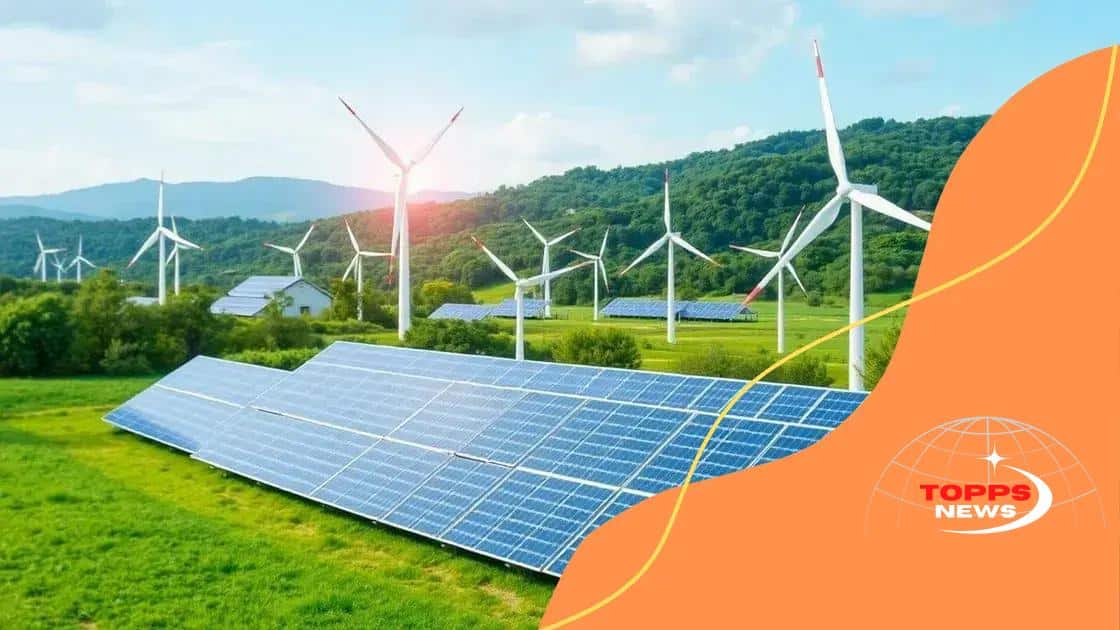Renewable energy public subsidies: a smart investment

Renewable energy public subsidies are financial incentives from governments designed to promote the adoption of clean energy technologies, reduce project costs, create jobs, and stimulate innovation in the renewable energy sector.
Renewable energy public subsidies are becoming essential in promoting sustainable practices. Have you considered how these initiatives can support a greener planet while offering significant financial benefits? Let’s delve into this topic and uncover what these subsidies mean for our future.
Understanding renewable energy public subsidies
Understanding renewable energy public subsidies is critical in today’s environmental landscape. These financial incentives aim to promote the use of clean energy sources while making them more affordable for consumers and businesses alike.
Governments worldwide are recognizing the importance of reducing greenhouse gas emissions and promoting sustainable development. Public subsidies play a pivotal role in this effort by lowering costs associated with renewable energy projects.
Types of Renewable Energy Public Subsidies
Various types of subsidies can encourage the growth of the renewable energy sector. These typically include:
- Tax credits that reduce the tax burden for companies investing in renewable technologies.
- Grants that provide direct funding to support energy projects.
- Subsidized loan programs that offer lower interest rates for renewable energy investments.
Each of these options lowers the initial investment barrier and encourages more companies to transition to cleaner energy solutions.
The Impact of Public Subsidies
The effects of public subsidies on the renewable energy market are significant. They not only increase the uptake of renewable sources but also stimulate job creation in the green economy. When the government invests in renewable energy, it can:
- Encourage innovation in renewable technologies.
- Support local economies and job growth.
- Help secure energy independence by reducing reliance on fossil fuels.
By understanding the benefits and mechanisms of these subsidies, consumers and businesses can make more informed decisions about their energy use. Additionally, policymakers can better design subsidy programs that maximize positive environmental outcomes.
In conclusion, grasping the concept of renewable energy public subsidies opens doors to a sustainable future. By leveraging these financial tools, we can advance toward cleaner energy alternatives while fostering economic growth.
Benefits of public subsidies for renewable energy
Benefits of public subsidies for renewable energy are numerous and impactful. These financial aids not only enhance the growth of clean energy technologies but also contribute to a more sustainable future for everyone.
One major benefit is the reduction of costs associated with renewable energy projects. With public subsidies, the upfront expenses of installing solar panels, wind turbines, and other renewable systems become much more manageable for individuals and businesses.
Economic Advantages
Subsidies can stimulate the economy in various ways:
- Creating new jobs in the renewable energy sector and related industries.
- Encouraging investment in local infrastructure.
- Enhancing energy independence by reducing reliance on imported fuels.
Furthermore, when renewable energy becomes more accessible, it leads to lower energy bills for consumers, enhancing their purchasing power.
Environmental Impact
The environmental benefits of public subsidies for renewable energy are profound. By promoting the use of clean energy sources, these subsidies can significantly reduce greenhouse gas emissions and combat climate change.
Additionally, cleaner energy sources improve air quality, leading to better health outcomes for communities. When we transition to renewable options, we also preserve natural resources for future generations.
Another key aspect is the potential for technological advancements. Public subsidies can foster innovation in renewable energy technologies. As more governments invest in research and development, we can expect to see breakthroughs that make renewable energy even more efficient and affordable.
These subsidies create a supportive environment for the growth of a green economy, ensuring that renewable energy becomes a viable option for all.
How to access renewable energy subsidies

How to access renewable energy subsidies is essential for individuals and businesses looking to invest in clean energy solutions. Knowing the steps to navigate this process can significantly decrease costs and make sustainable practices more attainable.
The first step is to research available subsidies at local, state, and federal levels. Many governments offer different types of financial assistance, such as tax credits, grants, and rebates. Understanding which programs are available is crucial for taking advantage of these benefits.
Identifying Eligibility
Each subsidy program has specific eligibility criteria. To determine if you qualify, consider:
- Geographic location, as some programs may only be available in certain areas.
- The type of renewable energy system being installed, such as solar, wind, or geothermal.
- Your energy usage and the overall size of your installation project.
Knowing these factors can help streamline the application process and increase the chance of approval.
Applying for Subsidies
Once you’ve identified suitable programs, the next step is to prepare your application. This often involves collecting necessary documentation such as:
- Proof of income or financial stability.
- Details about the project, including costs and installation plans.
- Any required permits or approvals already secured.
Carefully following the application guidelines is vital, as incomplete or incorrect submissions can lead to delays or denials.
After submitting your application, it’s important to stay up to date with the progress. Some programs may require follow-up steps or additional documentation. Being proactive ensures that you can receive your subsidies as quickly as possible.
By accessing renewable energy subsidies, you not only save money but also contribute to a more sustainable future. This financial support can make the transition to renewable energy more feasible and encourage others to follow suit.
Case studies: successful subsidy programs
Case studies: successful subsidy programs showcase how effective public subsidies can promote the adoption of renewable energy. These real-world examples highlight the benefits and strategies that can lead to success in sustainable energy initiatives.
One notable program is California’s Solar Incentive Program, which has significantly increased solar installations across the state. By offering substantial rebates for solar panel installations, the program enabled thousands of homeowners to adopt solar energy, drastically reducing their electricity bills.
Key Features of Successful Programs
Successful subsidy programs often share several key features, including:
- Clear eligibility criteria that make it easy for consumers to understand if they qualify.
- Financial incentives that are substantial enough to encourage adoption.
- Strong outreach and education efforts to inform potential beneficiaries about the available subsidies.
These aspects help to ensure the programs are effective and reach their intended audience.
International Examples
Looking beyond the United States, countries like Germany and Japan also have successful subsidy programs. Germany’s Feed-in Tariff system has encouraged the growth of the renewable energy sector by guaranteeing a fixed payment for energy produced from renewable sources. This stability has encouraged investments in wind and solar power, boosting energy generation significantly.
Similarly, Japan has implemented its own subsidy frameworks following the Fukushima disaster, focusing on solar energy adoption to enhance energy security and sustainability. These international examples illustrate the diverse approaches nations take to promote renewable energy through subsidies.
The impact of these subsidy programs often extends beyond just financial savings. They foster job creation, drive technological innovation, and promote environmental stewardship. By examining these successful case studies, other regions can learn valuable lessons and adapt their subsidy strategies to foster the growth of renewable energy.
Future trends in renewable energy funding
Future trends in renewable energy funding are shaping how we view and invest in clean energy technologies. As the world shifts towards sustainability, understanding these trends can help individuals and businesses prepare for the changes ahead.
One major trend is the increase in private investment in renewable energy. Many companies are looking to reduce their carbon footprint and are willing to invest in clean energy solutions. This private funding complements public subsidies, further accelerating the growth of the industry.
Impact of Technology on Funding
Technological advancements are also influencing funding trends. Innovations such as:
- Energy storage solutions that allow for better management of renewable energy.
- Smart grid technology that improves efficiency and reliability.
- Decentralized energy systems that empower communities to generate their own power.
These technologies are attracting investments by demonstrating their potential to change the energy landscape.
The Role of Policy and Regulation
Policies and regulations are critical in shaping funding for renewable energy. Governments are implementing various measures to encourage investment, including:
- Tax incentives specifically designed for renewable energy projects.
- Carbon pricing mechanisms that make fossil fuels less attractive financially.
- Increased funding for research and development in clean technologies.
As these policies evolve, they will play a significant role in determining how and where funds are allocated within the renewable energy sector.
In addition, the rise of green finance and sustainability bonds indicates a growing commitment to funding renewable energy projects. Investors are increasingly seeking to put their money into projects that align with environmental and social governance (ESG) criteria.
Overall, the future of renewable energy funding is moving towards a more integrated approach, combining public, private, and community investments to create a sustainable energy future. By understanding these trends, stakeholders can navigate the evolving landscape effectively.
FAQ – Frequently Asked Questions about Renewable Energy Public Subsidies
What are renewable energy public subsidies?
Renewable energy public subsidies are financial incentives provided by governments to promote the adoption and use of clean energy technologies.
How can I access these subsidies?
You can access these subsidies by researching available programs at local, state, and federal levels, then applying if you meet the eligibility criteria.
What are the benefits of renewable energy subsidies?
Benefits include reducing the cost of renewable energy projects, creating jobs, encouraging innovation, and helping the environment.
What future trends can we expect in renewable energy funding?
Future trends include increased private investment, advancements in technology, and evolving government policies that will continue to shape funding opportunities.





